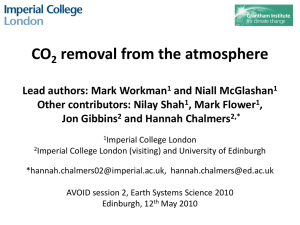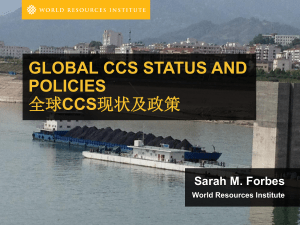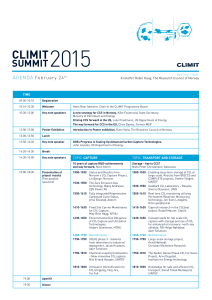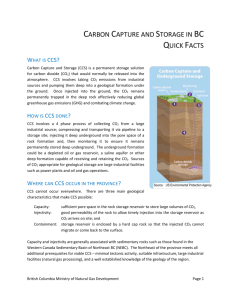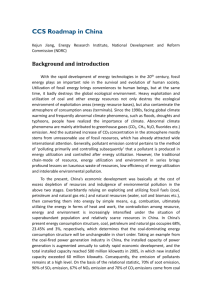Zero emission fossil fuel power plants
advertisement
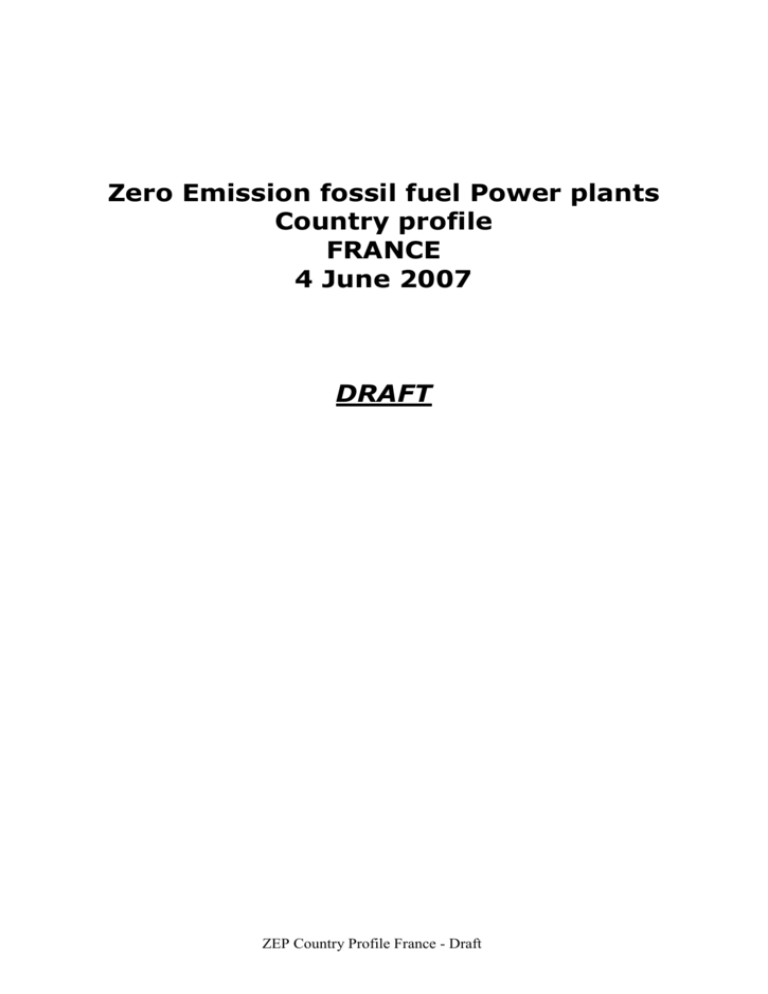
Zero Emission fossil fuel Power plants Country profile FRANCE 4 June 2007 DRAFT ZEP Country Profile France - Draft 1 Background information 1.1 - Some key facts about energy in France1: The population of France (62 million inhabitants) represents 1% of the world population. Its area (544,000 sq. km) is equivalent to 0.1% of the world's land mass. Its gross domestic product (1,710 billion euros in 2005) contributes 3.3% of the world GDP. Its primary energy consumption (275 Mtoe) is about 2.5% of world energy supplies (Total Primary Energy Supply : TPES). But it has only 0.01% of the known world fossil fuel reserves (23 Mtoe). France has been implementing energy saving measures since 1974 : energy intensity measures the energy consumption of the final sectors for the production of a unit of GDP, and may be used to evaluate the effort made by the French with regard to energy control. Between 1990 and 2006, the annual improvement was – 1.3%. France is the first or second (depending on the climate) largest producer of renewable energies in the European Union: 17,2 Mtoe in 2006. France is the world's 2nd largest producer of nuclear energy : 450 TWh in 2006 = 78% of electricity production in 2006. As a result of above three facts, France is a country which emits relatively little CO2 : compared with the OECD countries, in 2004, France is in 7th place for CO2 emissions per inhabitant and occupies 4th place (after Norway, Sweden and Switzerland) for CO2 emissions per unit of GDP (emissions from fuel combustion). 1.2 - In 2004, the General Directorate for Energy and Raw Materials has published a baseline reference scenario over the period 2004-20302. By convention, energy policies and measures taken into account in this scenario were those already decided at the end of 2003. Consequently, neither the provisions of the Energy Act (see below) nor the measures called for in the “2004 climate plan” had been considered. In this scenario, the total final energy consumption increases by 30% between 2000 and 2030, the conventional thermal electricity production increases from 53 TWh in 2000 to 187 TWh in 2030 and the share of fossil fuels in energy supply rises from 54% to 59%. As a result, national carbon emissions rise from 105 MtC in 2000 to 146 MtC in 2030. 1.3 - At present, French energy policy is defined by the Energy Act of 13 th July 2005. Among other things, this Act defines energy policy guidelines: 1) average reduction of final energy intensity of at least 2% per year from 2015 and of 2.5% from 2015 to 2030, 2) production of 10% of energy needs from renewable energy sources by 2010, 3) incorporation of bio-fuels and other fuels of renewable origin to a level of 2% in 2006, 5.75% by the end of 2008 and 7% in 2010. 1 2 Read also http://www.industrie.gouv.fr/energie/anglais/accueil.htm Read also http://www.industrie.gouv.fr/energie/prospect/pdf/scenario-2004-eng.pdf ZEP Country Profile France - Draft 4) a quartering of CO2 emissions by 2050, R&D is one of the four principal areas of actions identified in the Energy Act mentioned above. Supporting R&D is essential in order to meet long-term challenges, for example for bio-energies, fuel cells, clean vehicles, energy-efficient buildings, solar energy, 4thgeneration nuclear energy and capture and underground storage of CO2. 1.4 - A working group (“Factor 4”, chaired by a renown economist, Mr Christian de Boissieu) was formed in 2005 to explore the various paths towards reaching the “quartering of CO2 emissions” objective. It submitted a final report on 6 October 20063. One of the questions which the letter of engagement required the Factor 4 Group to answer was: “Is the Factor 4 objective feasible?” The answer is an unequivocal “YES”. A second question was: “Will it be easy?” The answer is a clear “NO”. This report states that high consumption of fossil fuels for power production is a “no-go option”, “except when combined with CCS and provided the latter has been agreed to as environmentally acceptable”. As far as fuels are concerned, “coal can continue as a source of energy provided that it is never used without CO2 capture and storage”. Because of the early stage of CCS development and because of the energy situation in France, this report does not view CCS as an “indispensable step” but as one of the three main “opportunities”. 2 R&D4 CCS development, along with other energy technologies development, is crucial. A lot of work is still needed before we can reach our targets. But the issues we have can be solved and we are increasing the pace. More R&D is needed, with two main objectives: reducing the cost and addressing the safety issues. CCS research in France is supported by a dynamic scientific community and highly motivated industrial players, including: - public research centres such as BRGM5, CNRS6 and IFP7 - private companies which could use CCS in the future (electricity producers, steel producers, refineries, cement industry) - private companies from the oil&gas service industry - private companies from other technology provider industries, such as Alstom and Air Liquide A “Club CO2”8 has been formed in 2002. Under the presidency of ADEME9 (French Agency for the Environment and Energy Management), the “Club CO2” gathers together major concerned players10 in the industrial sector and in research. 3 Read also http://www.industrie.gouv.fr/energie/prospect/pdf/facteur4-rapport-final-engl.pdf The focus of this part is on national projects. International projects involving French players are not described. 5 http://www.brgm.fr/ 6 http://www.cnrs.fr/ 7 http://www.ifp.fr/ 4 ZEP Country Profile France - Draft French players are deeply involved in European and international research devoted to CO2 capture and its long term storage, and this has been the case since the first European project, “The underground disposal of carbon dioxide” (Joule II Project 1993-1995), which demonstrated the feasibility of this technology and in which BRGM (Bureau de Recherches Geologiques et Minieres) took part. For over ten years, France has thus been involved in a majority of European projects. IFP is co-ordinating European projects such as Castor and Inca-CO2. France is also involved in international projects dealing with geological storage, particularly those associated with the first industrial applications (Sleipner and Weyburn). During the last ten years, the French authorities have significantly increased their support to R&D on CCS through research centres such as BRGM, CNRS and IFP and through projects funding agencies such as ADEME and ANR11. ANR (Agence Nationale de la Recherche) for example has launched in 2007 its third call for CCS projects. The ANR program funds private-public partnerships and covers all aspects of CCS development. As far as 2005 and 2006 are concerned, 20 projects (see below) have been selected and a funding of more than 16 M€ has been provided. 8 http://www.clubco2.net/ http://www.ademe.fr/ 10 http://www.clubco2.net/servlet/KBaseShow?sort=-1&cid=13990&m=3&catid=14010 11 http://www.agence-nationale-recherche.fr/ 9 ZEP Country Profile France - Draft 3 Implementation in France Group Total12 has launched a 60 M€ fully integrated CCS project in south-western France. CO2 capture, transport and injection are scheduled to begin end of 2008. This project calls for up to 150,000 metric tons of CO2 to be injected into a depleted natural gas field in Rousse (Pyrenees) over a period of two years as from end-2008. The first link in the chain is a steam production unit at the Lacq gas processing plant. Oxygen will be used for combustion rather than air to obtain a more concentrated CO2 stream that will be easier to capture. Once purified, the CO2 will be compressed and conveyed via pipeline to the depleted Rousse field, 30 kilometres from Lacq, where it will be injected through an existing well into a rock formation 4,500 metres under ground. Other CCS projects may be soon announced in France. The Agence de l'Innovation Industrielle13 (AII), which was established in August 2005 in order to promote and support major programmes for industrial innovation, is in close contact with the French R&D network and may also support future medium or large-size demonstration projects. 12 13 http://www.total.com/en/home_page/ http://www.aii.fr/srt/aii/home ZEP Country Profile France - Draft 4 Public acceptance In the latest Observatoire de l’Energie-CREDOC opinion poll on energy issues, French people have been asked whether they had previously heard about capturing CO2 on large industrial sites and injecting it underground: 78,6% of French people answered “no”. 9,5% answered “yes” and added that “this solution has advantages” 10,8% answered “yes” and added that “this solution has drawbacks” 1,1% did not answer or were not sure Another recent TNS SOFRES-CIRED opinion poll14 describes the evolution of opinions and answers when more information about CCS is given. In addition to those surveys, the following communication initiatives can be highlighted : - International Symposium in Paris “Reduction of emissions and geological storage of CO2” - 15 & 16 September 200515 - publication of a 44 pages booklet explaining what is CCS – September 2005 (also available in English) - conference “How to tame king coal?” in Le Havre – March 200716 - CSLF meeting in Paris - March 2007 - Stakeholders workshop on CCS acceptance organised by CIRED – April 200717 - International Symposium in Paris “Capture and geological storage of CO2 : innovation, industrial stakes and achievements” - 4 & 5 October 200718 5 Government policy19 As CCS has the potential to become one of the powerful tools we need to deal with the challenges of climate change, the French authorities have been active on issues related to CCS development. At the national level, the French authorities are acting in three main areas : R&D and demonstration : the financial support to R&D has been increased (see above). The two main objectives are to reduce the cost and to address safety issues. A short-term fully integrated demonstration has also been announced. Legal environment: legal environment for demonstration projects and rules to warranty the long term safety of the CO2 storage clearly need to be defined. The work in France is conducted in close relation with the international level (OSPAR, London Convention, EU, …). As an intermediary step, a report focusing on French legal environment has recently been published20. Communication : CCS public awareness is very low and more communication is clearly needed. Conferences, booklets, web sites, workshops with stakeholders and the demonstration in France (see above) are expected to have a positive impact on awareness. 14 http://www.centre-cired.fr/forum/IMG/pdf/main.pdf http://www.co2symposium.com 16 http://www.ecologie.gouv.fr/Colloque-leHavre-8et9mars2007.html 17 http://www.centre-cired.fr/forum/article498.html 18 http://www.co2symposium.com 19 Summary of government policy 20 http://www.industrie.gouv.fr/energie/prospect/cadre-jur-stockageco2.htm 15 ZEP Country Profile France - Draft



